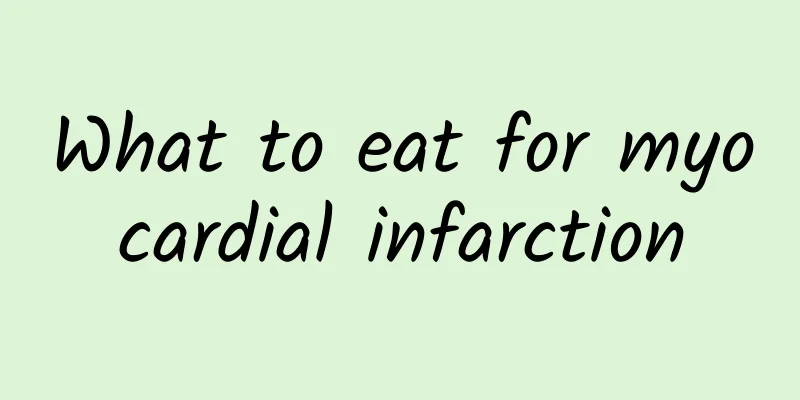What to eat for myocardial infarction

|
Myocardial infarction, as people often call it, is an acute myocardial infarction disease. Common symptoms include persistent pain behind the sternum that cannot be completely relieved by rest or medication. Myocardial infarction can also easily cause some complications such as arrhythmia, etc., which can even threaten people's lives in severe cases. So everyone must pay attention to this type of disease. If you feel any discomfort in your sternum, be sure to get checked out as soon as possible. Generally speaking, no matter what disease people suffer from, they will adopt some diet therapy in addition to drug treatment. You should know that most of the foods we eat on a daily basis have the ability to cure diseases. Therefore, when receiving drug treatment, you should also know what foods are good for your illness. Today I will share with you what to eat when you have myocardial infarction. What to eat for myocardial infarction (1) Acute phase: Absolute bed rest is required within 3 days of onset. All activities (including eating) require special care. For the first 1-3 days after onset, the liquid diet is mainly a small amount of vegetable water, oil-free filtered broth, red date paste soup, rice soup, porridge, juice, lotus root powder, oral rehydration, etc. For bloating and irritation solutions, soy milk, milk, strong tea, coffee, etc. are recommended. The total amount of rehydration is about 1000-1500 ml/24 hours, divided into 5-6 times. The daily calorie is 500-800 kcal. It is necessary to avoid overheating or overcooling to avoid arrhythmia. Sodium, potassium, and magnesium in food must be paid attention to. Generally, a low-salt diet is recommended, especially for patients with heart failure. Since sodium loss is common in the urine during an acute myocardial infarction, excessive restriction of sodium salt can also induce shock. Therefore, it must be adjusted appropriately according to the condition. In addition, for patients who can take it orally or according to the condition, parenteral nutrition can be supplemented. For patients with acute myocardial infarction, since they can move, the spleen and stomach function will be affected, so the food must be soft and easy to digest. (2) Remission period: Within 4 days to 4 weeks of onset, as the condition improves, gradually switch to semi-liquid food. Still, eat small meals frequently. During the acute phase, total energy increases to 4200-5040 kJ (1000-1200 kcal). Diet should be light, nutritious and easy to digest. It is allowed to eat porridge, oatmeal, evaporated milk, lean meat, fish, poultry, vegetables and water. Food should not be too hot or too cold. Eat small meals frequently. Keep the gastrointestinal tract unobstructed and avoid excessive straining during bowel movements. 3-4 weeks: As the patient gradually resumes activities, the diet should be relaxed appropriately. Fat and cholesterol intake should still be controlled. Patients with hypertension or chronic heart failure should still limit sodium intake. Obese people should eat less. Full meals (especially when eating a lot of fat) should be avoided because they can cause myocardial infarction to recur. Meals can increase blood lipids, increase blood viscosity, cause local blood flow to slow down, and platelets are easy to aggregate and cause thrombosis. In addition, the diet should also be restricted excessively to avoid malnutrition and increase the mental burden of patients. (3) Recovery period: The condition is stable for 4 weeks after the onset of the disease. As the patient's activity level increases, the daily calorie intake is generally maintained at around 1000-1200 kcal. Adequate high-quality protein and vitamins are beneficial to the repair of the lesion. Dairy protein, lean meat, fish, vegetables, water, etc. are all edible. In particular, green leafy vegetables and water are rich in vitamin C. Foods are beneficial and should be eaten regularly. The daily diet should also contain a certain amount of crude fiber to keep bowel movements smooth and avoid laborious defecation. In addition, relapses should be prevented during the recovery period. The dietary principles should also include maintaining an ideal body weight, avoiding full meals, controlling fat and cholesterol intake, preventing increased blood viscosity and platelet aggregation, quitting smoking and drinking, and limiting sodium intake for patients with hypertension and chronic heart failure. (4) Pay attention to the balance of water and electrolytes. The water content of food should be consistent with the amount of drinking water and infusion, and should be considered to adapt to the heart's load capacity. Patients with hypertension or heart failure should limit sodium salt intake. Clinically, it is also observed that acute myocardial infarction causes sodium loss in the urine, so adjustments should be made based on blood biochemical indicators. Some people have studied the nutritional metabolism of ischemic myocardium and found that magnesium has a good protective effect on ischemic cardiomyopathy. A certain amount of magnesium in the diet can help reduce the incidence and mortality of myocardial infarction. The magnesium requirement for adults is 300-400 mg/day. Food sources include colored vegetables, millet, flour, meat, seafood, etc. Potassium is known to affect myocardial excitability and conductivity. Hypokalemia is prone to arrhythmia, so attention should be paid to the occurrence of hypokalemia and dietary adjustments should be made. (5) Acute myocardial infarction with complete heart function often leads to gastrointestinal dysfunction. More attention should be paid to diet. In the first 1-2 days of the disease, only light, liquid food such as hot water, rice soup, honey water, lotus root powder, etc. should be given 6-7 times a day, 100-150 ml each time. If the patient's heart rhythm disorder improves and the pain is relieved, gradually increase the amount of lean meat, steamed egg white, thin rice porridge, etc. As the condition recovers, the coronary heart disease diet should be adopted for 6 weeks. The food should still be soft and easy to digest. (6) Pay attention to dietary adjustments during the high-incidence season. In late autumn and winter, when myocardial infarction is most likely to occur, in addition to keeping warm and preventing cold, you should also eat more mild foods that have the function of promoting blood circulation and removing blood stasis and are rich in nutrients, especially various medicinal porridges. It is suitable for patients with old myocardial infarction. Follow the general dietary arrangements for coronary heart disease. The above is what we introduce to you about what to eat more for myocardial infarction. Patients with this disease can eat more of this kind of food in their daily diet. There are many benefits to the treatment of illness. |
>>: How to treat neurasthenia correctly
Recommend
How to apply ice compress on double eyelids
After double eyelid surgery, the eyes will appear...
Herpes zoster
There are many types of diseases, and good method...
Huo Pu Xia Ling Tang Recipe Song
Huo Pu Xia Ling Tang has many functions. The whol...
Postpartum breastfeeding nipple pain, you need to take care of it like this
Breast milk plays a key role in the healthy growt...
What fruits can people with high blood sugar eat?
If your blood sugar is high, then the choice of f...
How to remove Bartholin gland cyst
Many people don’t know much about Bartholin’s gla...
Burping your baby too hard can hurt your baby
When the baby is breastfeeding, if the feeding is...
Blood coming out of anal fistula
Anal fistula is a common anal disease in our live...
Testosterone Growth Hormone
Testosterone, also known as testosterone, is a ho...
What department does gallbladder polyps belong to?
Many patients with gallbladder polyps do not have...
When will postpartum disease manifest itself?
Postpartum sickness usually appears after the con...
How to deal with heart pain when breathing?
The heart is the most important organ in the huma...
Symptoms of pharyngitis
There are many types of pharyngitis, such as alle...
Why does taking folic acid cause yellow urine?
When women are preparing for pregnancy or during ...
What should I do if my child develops large flat pimples?
Babies have relatively low resistance, so they ca...









